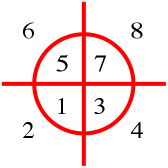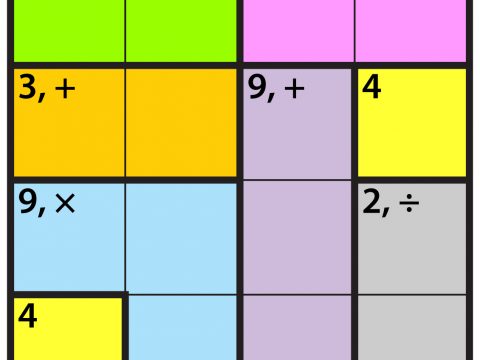What’s My Number?
Purpose:
The most important purpose is to help children develop their attention, focus and concentration, and working memory (see What are students learning, below). Children also develop the logic of the game, and some of the variations (see Variations, below) help them notice that logic. It is best to let them develop that logic entirely on their own. See Teaching suggestions below.
Rules:

A silent teaching game.
Setting up: The Secret-Keeper (at first, the teacher, though it can later be a student) displays this diagram, and says “I’m thinking of a number from 1 through 8.” After that, Secret-Keeper may not talk!
How to play:
- The Detectives (at first, all students in the class) ask yes/no questions to figure out the number.
- The Secret-Keeper
- nods “yes” or “no” to answer, or shrugs and looks puzzled if a nod won’t work (if the question isn’t clear or can’t be answered with a simple yes or no), and
- shows how many questions have been asked by holding up that many fingers, counting all questions that get answers, even if students, by error or carelessness, repeat a question that was asked earlier.
Winning: If the Detectives can name the number after asking four questions or less, they win. Otherwise, the Secret-Keeper wins.
Note: The Secret-Keeper is totally silent throughout the game, not even repeating students’ questions, so students need to speak up and listen to each other well.
What are students learning?
Because the teacher is silent, and because students win by asking no more than four questions, they must
- let one child ask
- listen to that answer
- watch your nod to get the response
- remember what has been asked and what the answers were
- interpret what they have learned, to narrow the remaining possibilities
- think up a new question.
More than learning a mathematical “technique,” they are learning to focus attention, remember, and use information.
Teaching suggestions
Ineffective questions: Children may ask a question for which they should already know the answer (because the question was asked before, or gives the same information as another question). For example, they might ask “is it 8” after learning it is below the line. Count the question, look amused or surprised or whatever suits you, and go on. As always in silent teaching, keep the silence during the game by saving any explanations for later. (Probably none will be needed, because some other child will chime in.)
Unanswerable questions: If they ask a question like “is it odd or even,” which you can’t answer with a head-nod, don’t count the question, but shrug or do whatever makes it clear you can’t answer.
Waiting for children to develop the logic: Avoid the temptation to short-circuit the learning by teaching adult-style questions. Adults start with questions like “Is it in the circle?” or “Is it even?” or “Is it greater than 4?” Children in first and second grade typically start with “Is it 3?” For a long time, what children are learning is just to listen, to remember, and to make sense of the questions that have already been asked. Give them time to learn how to focus and concentrate. Virtually all people acquire that adult logic naturally by the time they are adults, anyway, without games like this, but the experience playing the game and discovering the logic (not being told it) helps many children become logical thinkers earlier.
Modeling: As children get good at listening, you might invite them to pick a number while you step out of the room. Even this helps teach them control: They will have to control their decision and their volume because if they are too loud, you will hear! They should make sure that all children should know the secret number. When they are ready, one calls you back in. You can now ask one “sophisticated” question — like “Is it above the horizontal line?” or “Is it more than 4?” — along with questions like the ones they have been using. Don’t explain your technique; just use it. Then let them play again. They may or may not adopt your new questions.
Variations:
- When children find a way to win most of the time, challenge them to win with only three questions. If their logic is good and they’re paying attention, that is always possible.
- If they make a habit out of some question — for example, always asking “Is it in the circle?” or “Is it even?” — make the game interesting again by ruling that question out. “From now on, no more questions about geography: North/South, East/West, or in/out.” They’ll find other good questions!
- Use objects other than numbers and use categories for inside and outside the circle, for left and right, and for top and bottom. Here are some ideas. You can use color, shape, and size so children might ask “Is it blue?” or “Is it a square?”
Or you might use letters, and children could ask “Is it a vowel?” or “Is it in the first half of the alphabet?”
Or you might use words that practice some phonics or spelling idea: “Is it a one-syllable word? Does it have a short vowel?”
- Draw two grids, this one, and a second, using a blue marker, with the numbers 9 through 16. Because there are more numbers, they’ll need more questions, but if they’re already reliably able to win the 1-through-8 game in three questions, they should need only four questions for this variation.

